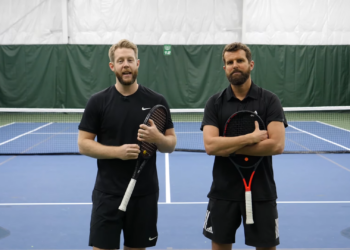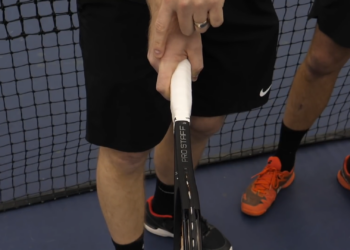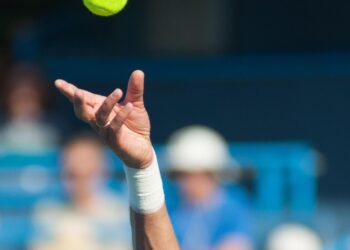Feel like you’re stuck at the intermediate level? Drilling your tail off but not improving in matches?
You’re not alone and trust me, I’ve been there.
You spend hours grinding through fed-ball drills, your strokes look clean in practice, but come match day… everything falls apart.
That heavy serve you’ve been working on? Suddenly it feels like it has a parachute attached. Those groundstrokes? More spray than accuracy. And don’t even get me started on the pressure points where your confidence evaporates faster than a drop shot in the sun.
Most intermediate players plateau not because they aren’t working hard, but because they’re drilling the wrong way. You don’t need more reps. You need the right reps.
PlayYourCourt helped thousands of players break through this wall by using smarter, live-ball drills that mirror real match conditions and fix the mental, not just mechanical, breakdowns.
In this guide, I’ll share battle-tested drills, game-based strategies, and real-world fixes that will help you finally start seeing match-day results that reflect your practice grind.
Let’s dive in.
Why Most Intermediate Players Plateau and How the Right Drills Can Fix It
There’s a wall in tennis that’s hard to see but impossible to ignore: the dreaded intermediate ceiling. You can rally, serve, and volley just fine… until the score matters.
You know how to hit the shots, but suddenly your timing is off, your confidence tanks, and your game unravels faster than your grip tape in July. Sound familiar?
This is where a lot of players get stuck, because the drills they’re doing don’t match the situations they’re facing in real play. I hear it all the time:
“Why do I play worse after drilling for an hour?”
“My coach just feeds balls, I’m not learning anything.”
“I drill great, but in matches I panic.”
Here’s the fix: ditch the static, one-size-fits-all drills.
PlayYourCourt builds training around live-ball, game-like scenarios where every rep has a purpose.
We simulate pressure. We mirror the chaos of real points. We train you to think and adapt, not just swing.
The 5 Pillars of Effective Intermediate Drills
If you want to level up your game, you need drills that actually translate to the matches you care about. That means targeting more than just technique, you need footwork, strategy, pressure handling, and confidence builders.
Below are the five needed categories we focus on to help our intermediate players unlock real, lasting improvement.
1. Footwork & Movement Drills
Why These Matter:
Let’s be honest: great strokes won’t save you if you’re always a step late.
At the intermediate level, footwork is the difference between reacting and dictating.
Before you fix your forehand, fix your feet. It’s not flashy, but it wins matches.
✅ Key Drills:
- Footwork Ladder Drill – Builds quick-twitch agility and control. Great as a warm-up before any hitting.
- Baseline Footwork Grid – Reinforces lateral and diagonal recovery patterns while hitting groundstrokes.
- Cone Movement Sprint – Players sprint in a figure-8 around cones between strokes. Boosts cardio and positioning.
- Recovery Step Drill – Teaches you to reset after every shot, essential for staying balanced and ready.
👉 Pro Insight: If you’re wondering, “Should I fix strokes or movement first?” – always choose footwork. Your technique can’t shine if you’re off-balance.
2. Consistency & Directional Control Drills
Why These Matter:
Consistency wins matches, especially at intermediate levels.
These drills develop the discipline to keep the ball in play and place it with intention. No more spraying forehands into the fence under pressure.
✅ Key Drills:
- Cross-Court Exchange Drill – Improves directional control and confidence in angled rally play.
- Butterfly Drill (Cross → Line) – Forces you to change direction quickly and think two shots ahead.
- Wall Target Drill – Perfect for solo practice; tape or chalk targets on a wall to simulate placement.
- Short Ball Recognition Drill – Trains fast transitions from baseline to offense on floating balls.
- Target Cone Challenge – Place cones in key court zones and aim your shots to hit or land near them.
✅ Pro Tip: Use colored cones or chalk markers to make your court look like a video game. More feedback = faster improvement.
3. Pressure + Match Simulation Drills
Why These Matter:
If you’re crushing it in practice but falling apart in matches, it’s your reps.
These drills recreate pressure, unpredictability, and chaos. The stuff that makes matches hard.
✅ Key Drills:
- Two-on-One Live-Ball Drill – Builds stamina and sharpens shot selection under heavy pressure.
- Serve Under Pressure Game – Simulate tiebreaker nerves by making every serve count toward a mini-match.
- Win-the-Mini Match Drill – Play three-point games within drills. Adds tension and decision-making.
- Strategy Partner Drill – One player mimics a pusher, the other an aggressive baseliner. Learn to adjust tactics.
- Mental Toughness Rallies – Intentionally frustrating rally drills to improve patience and focus.
- Reverse-Engineered Match Drills – Based on your last match performance, isolate key breakdowns and recreate them.
4. Net Play & Transition Drills
Why These Matter:
Net play is where points end. Most intermediate players are terrified of the net and it’s because they don’t drill it enough.
Transition drills train you to attack and finish with confidence.
✅ Key Drills:
- Volley Game Rotation Drill – Fast-paced, rotating net drill that sharpens reflexes and positioning.
- Overhead Smash Contest – Fun and competitive way to build confidence in putting balls away.
- Approach Shot + Volley Drill – Forces you to transition smoothly from baseline to net.
- Drop Shot → Lob Recovery Drill – Practice soft touch, sprint recovery, and overhead defense.
- Overhead Relay Circuit – Players hit overheads from different spots, then rotate. Trains footwork, timing, and anticipation.
📌 Pro Tip: Start every net drill with a split-step reaction toss to build anticipation instincts.
5. Serve + Return Focused Drills
Why These Matter:
At the intermediate level, your serve and return determine whether you start a point in control or playing defense.
These drills develop variety, placement, and mental toughness under pressure.
✅ Key Drills:
- Serve Consistency Game – Score points only when first serves land in. Builds confidence without fear of double faults.
- Slice + Kick Serve Practice – Introduce new spins and placements to disrupt opponents.
- Ball Toss Isolation Drill – Simplest drill, yet game-changing. Repetition builds toss precision.
- Return Ladder Drill – Return increasingly difficult serves with a focus on depth and control.
- Coach Toss & Reaction Return Drill – Coach tosses serve-like balls with varying pace and spin. Train quick adjustment.
These five pillars form the foundation of real improvement. Nail these, and you’re not just training, you’re transforming. Want help figuring out which pillar to start with? That’s where we come in.
Unique Drills Only the Pros Use (But Are Easy to Learn)
Intermediate players often assume that pro-level drills are out of reach, too technical, too advanced, or too complex.
Some of the most effective pro drills are shockingly simple.
They just target the right stuff: anticipation, awareness, efficiency, and decision-making.
These three drills are staples in the PlayYourCourt system because they deliver high returns with low complexity, ideal for players stuck at that “almost there” level.
Player Mirror Drill
What It Does: Improves footwork rhythm, spatial awareness, and mental connection with movement.
How It Works: Two players shadow each other along the baseline, mimicking each other’s movement in real time – side steps, shuffles, pivots. No ball necessary. It’s about syncing with rhythm and staying balanced, just like you need to in real rallies.
Why It Works for Intermediates: Too many players move after the ball is hit. This trains you to anticipate and move with the game, not behind it. Also a sneaky good cardio workout.
Split Step + Reaction Toss
What It Does: Builds fast-twitch reaction time and resets footwork habits, ideal for match starts or return games.
How It Works: A coach or partner yells “Go!” and tosses a ball left or right after your split step. You react and sprint to catch or hit it. The goal is explosive reaction, not perfect technique.
Why It Works for Intermediates: The split step is everything, yet most players botch it under pressure. This drill grooves it into your muscle memory so it becomes automatic, not forgotten in big moments.
Multi-Goal Circuits
What It Does: Blends physical fitness, tactical decision-making, and shot execution, game-day ready training in one sequence.
How It Works: Set up a drill that incorporates movement (e.g., sprint to cone), then a shot (e.g., forehand to deep target), then a decision (e.g., volley or retreat). It’s dynamic and changes every rep.
Why It Works for Intermediates: This is where many players feel overwhelmed: “Too many things to think about!” That’s exactly why we train it. These circuits develop the ability to process and perform at the same time.
Still Not Improving? Here’s Why Your Drills Might Not Be Working
Let’s talk about the elephant on the court.
You’re showing up. You’re sweating. You’re doing the drills. But your game? Still stuck.
Before you throw in the towel, let me show you why that might be happening and more importantly, how to fix it.
Bad Coaching: “My coach just feeds balls”
This is one of the most common complaints I hear from intermediate players. Static feeding from the basket can be useful if it’s part of a larger plan.
But on its own? It’s like learning to swim on dry land.
PlayYourCourt emphasizes live-ball drills, where your decisions, footwork, and timing actually mirror what happens in a match.
These drills force you to think, move, and execute under pressure, just like real play. If your coach isn’t helping you simulate game conditions, it’s time to level up your training.
Peer Pressure: “Others judge my mistakes during drills”
You know the feeling, group drills where someone rolls their eyes when you miss. Not exactly confidence-boosting.
We built PlayYourCourt to solve this. You can train 1-on-1, in private partner sessions, or with a perfectly matched group that’s at your level.
No pressure, no judgment, just smart, strategic reps that help you improve faster.
Wrong Level: “Am I still using beginner drillsl?”
Great question. Here’s a quick checklist. If you’re still doing drills that…
- Involve mostly static feeds
- Require no decision-making
- Don’t change pace or direction
- Don’t simulate pressure moments
…then yes, you’re stuck in beginner territory.
Intermediate players need drills that challenge their movement, mental game, and match tactics. If you’re not sweating and thinking, the drill’s not doing its job.
Build Your Own Weekly Intermediate Drill Plan (Free Template)
One of the biggest breakthroughs I’ve seen with intermediate players is about planning smarter.
Improvement doesn’t come from just showing up and hitting balls. It comes from having a structured training plan that balances technique, tactics, movement, and mental toughness.
Here’s how to design your week like a pro, even if you’ve only got a few hours to train.
Your Weekly Drill Blueprint
Monday: Solo Technical Work (30–45 min)
- Wall Target Drill
- Shadow Swing Routines
- Ball Toss Isolation Drill
👉 Perfect for off days or when you don’t have a hitting partner. Use a wall or court with cones for precise feedback.
Tuesday: Partner Control & Movement (60 min)
- Cross-Court Exchange Drill
- Footwork Ladder → Live Ball Transition
- Short Ball Recognition + Target Cone Drill
👉 Emphasize directional hitting, spacing, and recovery. Low-pressure, high-rep day.
Wednesday: Rest or Light Movement
Optional light cardio or yoga. Footwork-focused shadow drills if you’re eager to move.
Thursday: Tactical + Pressure Simulation (75 min)
- Two-on-One Rally Drill
- Win-the-Mini Match Drill
- Serve Under Pressure Game
👉 This is your “real match” training day. Pressure drills build mental strength and problem-solving.
Friday: Net Play & Transitions (45–60 min)
- Volley Game Rotation Drill
- Overhead Smash Contest
- Drop Shot → Lob Recovery Drill
👉 Start each with a split-step toss. Emphasize decision-making between staying back or moving in.
Saturday: Full Match Simulation / Group Drill Day
- Reverse-Engineered Match Drills (based on your last game)
- Doubles Coordination Drill
- Strategy Partner Drills: Pusher vs Aggressor
👉 Great for PlayYourCourt small group sessions or matchplay clinics.
Sunday: Optional Recovery + Video Session
Review match footage or watch pro coaching tips in the PlayYourCourt video library. Focus on learning, not sweating.
Training Modes:
- Solo: Wall drills, shadow swings, toss practice
- Partner: Target drills, movement games, live-ball exchanges
- Group: Pressure scenarios, game-based drills, strategic match play
PlayYourCourt Tools to Accelerate Your Progress
- Video analysis with pro coaches like Nate
- Skill challenges to test your serve, forehand, and more
- Match tracking tools and personalized improvement feedback
On-demand drill libraries based on your level
Ready to Improve Faster? Start Here.
If you’ve made it this far, you’re not just an intermediate player, you’re an invested one.
We’ve walked through proven drills, broken down mental traps, and shared the pro-level strategies we use every day to help players like you improve faster.
But real progress comes from doing the right ones, the right way, at the right time.
That’s why we built the new PlayYourCourt membership, not around generic practice partners, but around game improvement.
Whether you’re trying to add 15mph to your serve, stop losing to pushers, or finally start winning close matches, our platform gives you exactly what you need:
- 🧠 Live drills that mimic match conditions
- 🎥 Personalized coach feedback (from pros like Nate Dogg)
- 🏆 Challenges, matchplay, and performance tracking
- 🤝 Partner matching, but with a purpose, getting better
Explore our membership and start your free 7-day trial today.



